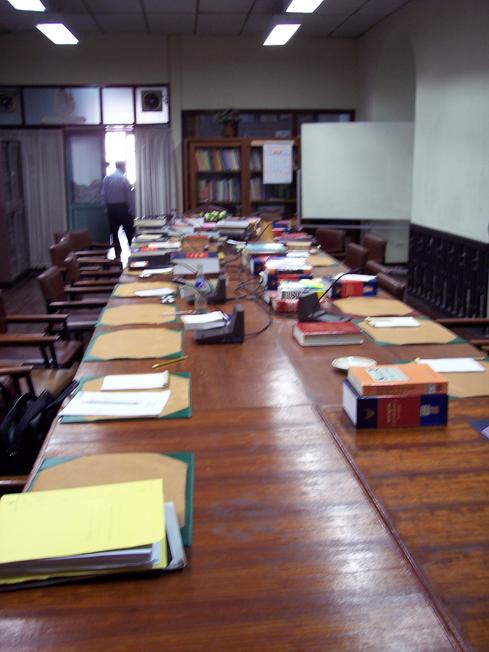The dreaded weekly project status meeting. The pointless spin session. The 20-person cruise to nowhere. Can we end meetings as we know them?

We all waste an inordinate amount of time in useless, aimless meetings. I've even worked at organizations that meet to meet -- they schedule a meeting to determine the agenda of yet another meeting.
We need to start asking ourselves: What's the purpose of this meeting? If it isn't to reach a decision on some issue or task, it isn't a meeting. It's a lecture, presentation, or sales pitch. Its goal is to reach a consensus (whatever that is) or to stroke someone's ego. Let's at least call it what it is.
We also need to keep true meetings to six or fewer people, because meetings of more than six aren't conducive to making decisions. Why six? It's a reliable management axiom that an individual should have no more than five direct reports. Any more tends to lead to confusion, lack of coordination, and poor decision making. (Just look at the government and its umpteen Cabinet heads.) The same thinking applies to meetings. If decisions are required across lines of business, you should still keep the meeting to the five or six people who need to be involved to reach decisions.
Once those five or six people come to a decision, they can present it to a broader group over email, via WebEx, or in some dreary conference room with PowerPoint slides. Just don't call it a meeting.
[How well do you really understand the details of that software contract? Read Software Contracts 101: What To Look For.]
Now, you say, what about status meetings that may involve 20 or more people? Here, the team leads or department heads are expected to present the status of a project, quarterly results, etc. with whatever spin they can apply. These aren't really meetings; they're another form of presentation. If there's no decision making, there's no meeting.
If we must have these presentations/spin sessions, let's lay out some ground rules so we can give them a modicum of excuses for existing:
They have a single focus or objective: project status or update, presentation of results, new product offering, etc.
They come with an agenda that gets distributed before the presentation.
They carry an allotted time, with a hard stop at 60 minutes -- 30 minutes is better.
They're led by a meeting czar, who keeps things moving and cuts off self-promoters and navel gazers.
They don't produce decisions. All decisions in these kinds of sessions get made beforehand in true meetings with the main decision makers.
They allow only limited discussion. Each person presents his or her status or findings in a cogent manner.
They allow only limited use of slides. Focus on what people say, what decisions have been reached, and what the next set of tasks or decisions are.
They ban email checking and web surfing on smartphones, tablets, or laptops.
There are other ways to keep a meeting tight and on schedule. For example, you can require all attendees to stand and keep their comments to three minutes or less. (Your organization may or may not find this tactic helpful, depending upon the culture.)
In my experience over many years as a senior operations, technology, and project manager, I found that line operations and production managers tended to run the best meetings. Vendors ran the worst ones. Project management officers fell somewhere in between. My guess is that line managers know that time is money, so they demand the facts and just the facts. Vendors are always selling, so they let meetings drift into bunny trails -- lots of conversation with no tangible benefit. Project managers get caught up with the need for consensus (goodness knows why), so they seek approval from everyone, which we know is unattainable.
As the CIO of a large bank, I reported to the head of operations. He ran a tight meeting. Each person had about three minutes to provide a status. If anyone interrupted a speaker with a question that wasn't germane, the person was asked to hold the question until his or her scheduled time to speak. At the other extreme, I recently attended (usually remotely) weekly project status meetings run by a vendor project manager. He let attendees wander around the subject. Of course, the fact that he liked to "socialize" issues before "solutioning" a response created a loose environment. I wanted to call time out and put him in a penalty box.
Let's put an end to unproductive meetings. Let's hold to a tight schedule and make decisions in small groups. We'll not only get more real work done, but we'll also earn the gratitude of our meeting-maligned colleagues.
Got examples of what works and doesn't work in the meetings you've participated in or been subjected to? Please weigh in with a comment below.
The InformationWeek Conference is an exclusive two-day event taking place at Interop where you will join fellow technology leaders and CIOs for a packed schedule with learning, information sharing, professional networking, and celebration. Come learn from one another and honor the nation's leading digital businesses at our InformationWeek Elite 100 Awards Ceremony and Gala. You can find out more information and register here. In Las Vegas, March 31 to April 1, 2014.
About the Author(s)
You May Also Like







